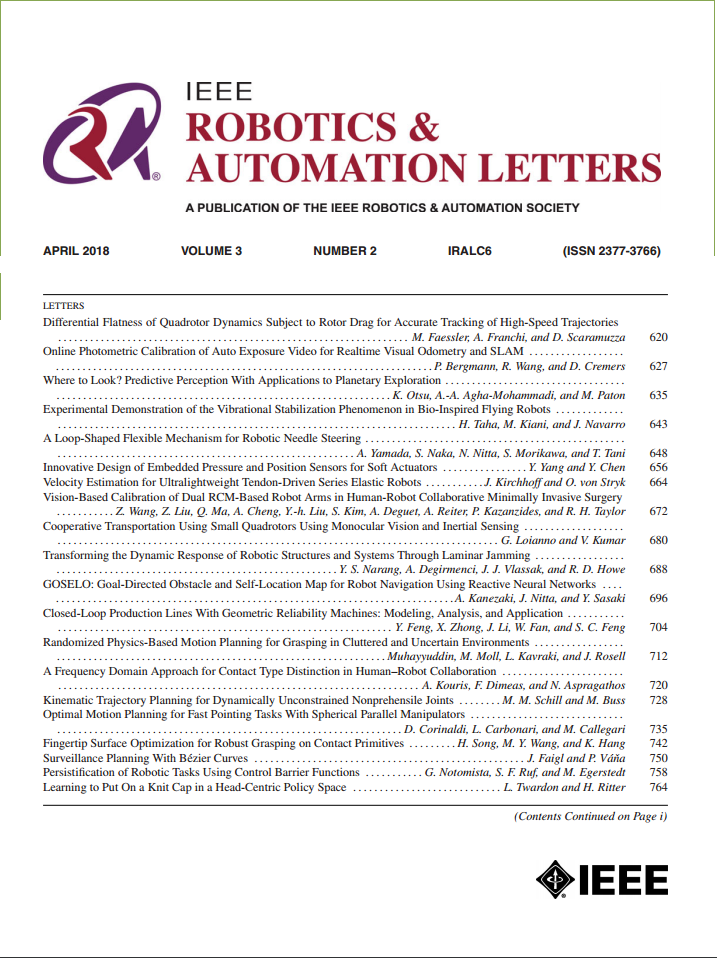SLIM:一个对称的、低惯性的机械臂,适用于受限的、接触丰富的空间
IF 5.3
2区 计算机科学
Q2 ROBOTICS
引用次数: 0
摘要
在受限和杂乱的空间中操作对机器人机械手提出了挑战,部分原因是与人的手和手臂相比,它们笨重的连杆几何形状和运动学限制。为了解决这些限制,我们引入了SLIM,一种定制的末端执行器,由双向手和集成的2轴手腕组成。拇指与手掌相对,手指向两个方向弯曲,手的形状像一个铰接的桨,可以穿过缝隙,在杂乱中移动。系列弹性驱动将手指惯性与电机惯性解耦,能够使用小型高齿轮电机进行有力的抓取,同时保持低有效终点质量。拇指安装在一个棱镜轴上,可以调整大小物体的抓握宽度。我们通过计算增加抓取获取区域,减少物体重定向时的扫描体积以及减少端点质量来说明设计优于传统解决方案的优点。与传统的平行爪钳相比,SLIM的薄外形可以在受限的环境中更快、更成功地完成远程操作任务。此外,它的双向手指允许演示者比拟人化的手更有效地完成顺序拾取任务。本文章由计算机程序翻译,如有差异,请以英文原文为准。
SLIM: A Symmetric, Low-Inertia Manipulator for Constrained, Contact-Rich Spaces
Operation in constrained and cluttered spaces poses a challenge for robotic manipulators, in part due to their bulky link geometry and kinematic limitations in comparison to human hands and arms. To address these limitations, we introduce SLIM, a custom end-effector consisting of a bidirectional hand and an integrated 2-axis wrist. With an opposing thumb that tucks alongside the palm and fingers that bend in both directions, the hand is shaped like an articulated paddle for reaching through gaps and maneuvering in clutter. Series elastic actuation decouples finger inertia from motor inertia, enabling use of small, highly-geared motors for forceful grasps while maintaining a low effective end-point mass. The thumb is mounted on a prismatic axis that adjusts grasp width for large or small objects. We illustrate advantages of the design over conventional solutions with a computed increase in grasp acquisition region, decrease in swept volume when reorienting objects, and reduced end-point mass. SLIM's thin form factor enables faster and more successful teleoperated task completion in constrained environments compared to a conventional parallel-jaw gripper. Additionally, its bidirectional fingers allow demonstrators to complete a sequential picking task more efficiently than with an anthropomorphic hand.
求助全文
通过发布文献求助,成功后即可免费获取论文全文。
去求助
来源期刊

IEEE Robotics and Automation Letters
Computer Science-Computer Science Applications
CiteScore
9.60
自引率
15.40%
发文量
1428
期刊介绍:
The scope of this journal is to publish peer-reviewed articles that provide a timely and concise account of innovative research ideas and application results, reporting significant theoretical findings and application case studies in areas of robotics and automation.
 求助内容:
求助内容: 应助结果提醒方式:
应助结果提醒方式:


